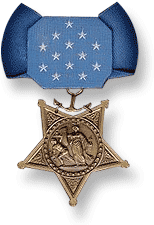|
John Kelvin Koelsch
John Kelvin Koelsch (December 22, 1923 – October 16, 1951) was a United States Navy officer and a recipient of America's highest military decoration — the Medal of Honor — for his actions in the Korean War. He was the first helicopter pilot to be awarded the Medal of Honor. BiographyJohn Kelvin Koelsch was born in London and was educated at the Choate School and Princeton University.[1] He served in the British RAF and fought in The Blitz before he joined the U.S. Naval Reserve as an aviation cadet on September 14, 1942, and was commissioned as an ensign on October 23, 1944, after completing flight training he served in the Pacific War. During the next few years, he served at Naval Air Stations at Fort Lauderdale, Florida, and Norfolk, Virginia, and subsequently flew with Composite Squadron 15 and Torpedo Squadrons 97 and 18. He became an accomplished torpedo bomber pilot, and was promoted to lieutenant (junior grade) on August 1, 1946. Despite first entering Princeton in September 1941, he returned to the university after the war, and finally graduated in 1949.[1] After the outbreak of the Korean War, he joined Helicopter Squadron 1 (HU-1) at Miramar, California, in August 1950. As Officer in Charge of a helicopter detachment, he joined USS Princeton in October for pilot rescue duty off the eastern coast of Korea. He served in Princeton until June 1951, when he joined Helicopter Squadron 2 (HU-2) for pilot rescue duty off Wonsan, Korea, then under naval blockade. He provided lifeguard duty for pilots who were downed either in coastal waters or over enemy-held territory. On June 22, he rescued a naval aviator from the waters of Wonsan Harbor, southeast of Yo Do Island. Late in the afternoon of July 3, 1951, Koelsch responded to a distress call from a Marine aviator, Captain James V. Wilkins, whose F4U Corsair had been hit by enemy fire during an armed reconnaissance mission about 35 miles (56 km) southwest of Wonsan. Wilkins parachuted from his burning plane at low altitude and survived, despite being severely burned about the legs. Despite approaching darkness, worsening weather, and enemy ground fire, Koelsch located the downed aviator in the Anbyon Valley and began his pickup. Thick fog prevented the air cover from protecting the unarmed HO3S helicopter, and intense enemy fire downed the craft as crewman George M. Neal, AM3, hoisted the injured pilot toward the helicopter. All three men survived the crash; and, after hiding in the mountains from enemy patrols for three days, they began a slow march to the coast. After six more days, they reached a coastal village where they were captured the following day while hiding in a hut. During his captivity, though beaten and abused, Koelsch refused to aid his captors or submit to interrogation. His fortitude and personal bravery inspired his fellow prisoners.  Koelsch died of malnutrition and dysentery on October 16, 1951, while a prisoner of war. On August 3, 1955, he was posthumously awarded the Medal of Honor for his actions in Korea.[2] He is buried at Arlington National Cemetery, Arlington, Virginia. His grave can be found in section 30, grave 1123-RH.[3] Awards and honors
Medal of Honor citation  Lieutenant (jg) Koelsch's official citation reads:
NamesakeThe destroyer escort USS Koelsch (DE-1049) (later reclassified as a frigate) was named in his honor. See alsoReferencesInline
General
|
|||||||||||||||||||||||||||||||||||||||||||
Portal di Ensiklopedia Dunia

